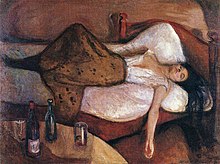Alcohol-related crime
[1][2] Underage drinking and drunk driving are the most prevalent alcohol-specific offenses in the United States[1] and a major problem in many, if not most, countries worldwide.
[6] Policing alcohol-related street disorder and enforcing compliance checks of alcohol-dispensing businesses has proven successful in reducing public perception of and fear of criminal activities.
The most prevalent type of fraud is one where wines are adulterated, usually with the addition of cheaper products (e.g. juices) and sometimes with harmful chemicals and sweeteners (compensating for color or flavor).
In Australia, a sly-grog shop is an unlicensed hotel, liquor-store or other vendor of alcoholic beverages, sometimes with the added suggestion of selling poor-quality products.
Some countries have a tiered structure that limits the sale of stronger alcoholic drinks to older adults (typically based on the percentage of ABV) Other restrictions that some countries impose is based on the place in which alcohol is consumed, such as in the home, in a restaurant, or in a bar.
For example, in England and Wales, buying alcohol on behalf of a person under 18 is a summary offence under section 149 of the Licensing Act 2003, punishable by an unlimited fine (level 5 on the standard scale).
A BAC or BrAC measurement in excess of the specific threshold level, such as 0.08%, defines the criminal offense with no need to prove impairment.
Research found that factors that increase the likelihood of alcohol-related violence include difficult temperament, hyperactivity, hostile beliefs, history of family violence, poor school performance, delinquent peers, criminogenic beliefs about alcohol's effects, impulsivity, and antisocial personality disorder.
[citation needed] While alcohol use correlates positively with crimes and violence, there is no simple, causal and direct relationship.
These include the unborn fetus and children of parents who drink excessively, drunk drivers, accidents, domestic violence and alcohol-related sexual assaults.
However, restricted usage of alcohol as seen in events such as the 2022 Qatar World Cup, was effective in reducing the level of hooliganism that has been previously seen in other major tournaments.
Discarded alcoholic beverage containers, especially broken glass shards that are difficult to remove, does not only create an eyesore but may also cause flat tires for cyclists, injure wildlife or kids.
Alcohol consumption can contribute to nighttime noise pollution, especially through loud music played by intoxicated individuals.
[28][8] A 1983 study for the United States found that 54% of violent crime perpetrators, arrested in that country, had been consuming alcohol before their offenses.
This includes alcohol-facilitated sexual assault which is considered rape in most if not all jurisdictions,[32] or non-consensual condom removal which is criminalized in some countries (see the map below).
A 2008 study found that rapists typically consumed relatively high amounts of alcohol and infrequently used condoms during assaults, which was linked to a significant increase in STI transmission.
Some people turn to drugs or alcohol to cope with emotional trauma after a rape; use of these during pregnancy can harm the fetus.
[34] One of the most common date rape drugs is alcohol,[35][36][24] administered either surreptitiously[37] or consumed voluntarily,[35] rendering the victim unable to make informed decisions or give consent.
For example, rape during the liberation of Serbia was committed by Soviet Red Army soldiers against women during their advance to Berlin in late 1944 and early 1945 during World War II.
Intoxication can impair judgment and lower inhibitions, increasing the likelihood of risky behavior like theft or violence.
Since the consumption of alcohol negatively impacts the brain function, drunk people fail to assess the situation which often results in overreacting and unpredictable fights.
Alcohol itself does not directly lead to violence but it acts as a catalyst, allowing cheers from the crowds or provocation from opponents to ignite the fight between fighters.
[52] Alcohol-fueled vandalism is a form of destructive behavior that occurs when individuals under the influence of alcohol damage or destroy property, often public or private, that doesn't belong to them.
This vandalism can range from minor acts like spray-painting graffiti or breaking windows to more serious offenses like damaging vehicles or buildings.
Additionally, the disinhibition caused by alcohol can lead to a sense of anonymity or invincibility, further emboldening individuals to commit vandalism.
Social settings where heavy alcohol consumption is present, particularly those with large groups, can create a sense of conformity or peer pressure, increasing the likelihood of vandalism.
2. c. 40) which was enacted to reduce the consumption of gin and other distilled spirits, a popular pastime[56] that was regarded as one of the primary causes of crime in London.
[57] Gilbert Paul Jordan (aka The Boozing Barber) was a Canadian serial killer who is believed to have committed the so-called "alcohol murders" between 1965-c. 2004 in Vancouver, British Columbia.










